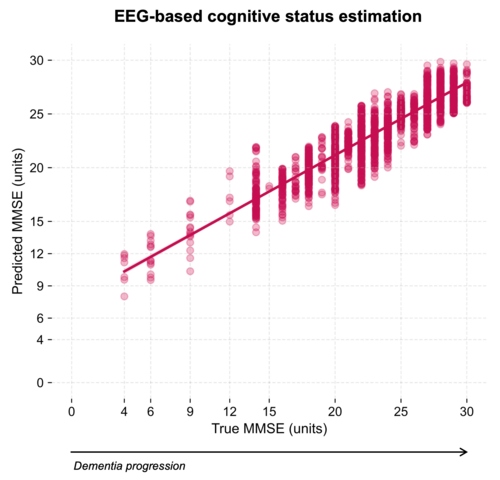Our research group, along with the CombiDiag consortium, is going to be present at the Alzheimer’s Association International Conference 2025 (AAIC25), focusing on scalable and technological solutions for monitoring cognitive decline and dementia in aging populations. The long-standing partnership of the Hybrid Method in Artificial Intelligence and Machine Learning (HAIML) group and the German Center for Neurodegenerative Diseases (DZNE) in Rostock continues to produce high-quality research in interdisciplinary computer science, particularly applied for biomedical research.
The role of EEG and other modalities in a comprehensive dementia model
With Alzheimer’s disease placing increasing pressure on healthcare systems worldwide, there is a critical need for accessible and continuous monitoring of cognitive health. While the Mini-Mental State Examination (MMSE) remains a standard tool, its adaptation for digital and home-based use is underway. At the same time, electroencephalograms (EEG), speech and blood-based biomarkers are emerging as promising, non-invasive tools for cognitive assessment outside clinical settings. In a cross-sectional study, we analyzed data from an international cohort of +500 older adults (aged 40-98) across France, Greece, England, Turkey, Argentina, and Colombia. Participants exhibited a wide range of cognitive abilities, as measured by MMSE scores from 30 (cognitively normal) to 4 (severe dementia). We developed multiple machine learning models to estimate cognitive status from EEG features, focusing on spectral, complexity, connectivity measures, and current density.
Key Findings
- Alzheimer’s presence: Alpha and theta eLORETA current densities are able to discriminate subjects with and without Alzheimer’s with 95% precision and 94% recall.
- Dementia staging: Hjorth Complexity in the left temporal lobe, alpha coherence between temporal lobes, and beta occipital edge frequency were among the strongest EEG predictors of cognitive status. Our best model achieved an R² value of 0.80 when predicting cognitive status, with an average error of just 2.53 MMSE points, demonstrating robust predictive power.
- Generalizability: The diversity of our cohort supports the applicability of these findings across different populations.
Future Directions
Our results highlight the potential for EEG-based, machine learning-driven tools to enable scalable, periodic monitoring of cognitive health — particularly valuable in regions with limited access to specialized staff or imaging technology. Ongoing work will focus on conducting longitudinal studies to track changes over time and prototyping mixed modular early diagnosis protocols with speech and blood-based biomarkers being validated in the CombiDiag consortium. This work, entitled "Cross-Sectional Associations Between EEG Features and Cognitive Status”, will be shared by João Saraiva at the AAIC25 in Toronto, Canada on July 29th.

